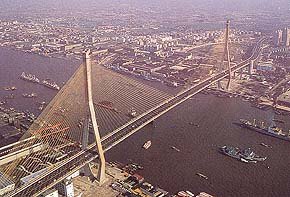Dal 1995 il sistema bancario cinese vive una autentica rivoluzione, materializzata sia da un nuovo assetto legislativo che da un nuovo assetto organizzativo nei diversi ambiti e nei diversi settori.
La Banca popolare di Cina (People's Bank of China) ha un ruolo centrale in questa riorganizzazione finanziaria e di conseguenza aumenta gli sforzi e gli studi per una discussione approfondita sul sistema bancario.
La Banca popolare di Cina ha offerto dunque all'Associazione questi tre testi di studio che volentieri pubblichiamo.
The development and supervision of the banking sector
The development and supervision of the cooperative finance
The cooperative finance in both urban and rural areas developed steadly in the process of consolidation and reform in 1997. Meanwhile, the accumulated risks over many years in the operations of the cooperative finance are also gradually exposed. In 1998, the cooperative finance will continue to improve its operation and management, minimize financial risks, coupled with further consolidation and reform.
The urban cooperative finance
 At the end of 1997, there were 3500 urban credit cooperatives throughout the country, with total assets of RMB326,6 billion yuan (of which the outstanding loans were RMB193,4 billion yuan), total liabilities of RMB317,3 billion yuan (of which the outstanding deposits were RMB 248,7 billion yuan) and owners’ equity of RMB9,3 billion yuan. Most of the urban credit cooperatives were relatively stable in terms of their operations.
At the end of 1997, there were 3500 urban credit cooperatives throughout the country, with total assets of RMB326,6 billion yuan (of which the outstanding loans were RMB193,4 billion yuan), total liabilities of RMB317,3 billion yuan (of which the outstanding deposits were RMB 248,7 billion yuan) and owners’ equity of RMB9,3 billion yuan. Most of the urban credit cooperatives were relatively stable in terms of their operations.
Developing urban credit cooperatives is an important part of the financial system reform. Since their creation, the urban credit cooperatives have played a positive role in supporting the development of collective and individual sectors, providing financial services to small enterprises, providing convenience for the general public, promoting competition in the financial sector and invigorating economic activity. However, the operations of most of the urban credit cooperatives have deviated from the original business intention. These institutions have evolved into the commercialized financial institutions aimed at profitability, and are confronted by the problems of small-scale operations, poor management and large financial risks.
The reform of the urban credit cooperatives consists of two aspects: some of the urban credit cooperatives are being transformed into commercial banks and delinked from the cooperative finance business, while the others will be restructured strictly based on the principle of the cooperative finance system. The People’s Bank of China (PBC) issued the revised Regulations on Urban Credit Cooperatives and the Regulations on the United Urban Credit Cooperatives in 1997, and will strive in two or three years to restructure those urban credit cooperativs not designed to become urban commercial banks into cooperative financial institutions with residents and enterprises in the communities as shareholders, democratically managed and aimed at providing financial services rather than making profits, and to establish a management mechanism under wich urban credit cooperatives will be managed according to laws and regulations, accountable for profits and loses, self-accumulated and self-disciplined.
Efforts will also be made, based on the successful experience in the cooperative finance development abroad and the prudential principle, to establish unified financial and accounting systems, further strengthen supervision with a view to increasing the ability of urban credit cooperatives to deal with financial risks, and set up the financial risk control system tailored to China’s circumstances.
The rural cooperative finance
At the end of 1997, there were 48586 rural credit cooperatives with independent accounting responsibility, 2380 united credit cooperatives at the county (city) level, 60990 credit cooperative branches and savings agencies without independent accounting responsibility, 220000 outlets, and consequently, one thousand peasants on average are being served by a credit cooperative agent. At the end of 1997, there were total assets of RMB1450,3 billion yuan in the rural credit cooperatives (of which the total outstanding loans were RMB727,3 billion yuan), total liabilities of RMB1413 billion yuan (of which the total outstanding deposits were RMB1055,6 billion yuan, including the outstanding houseold savings of RMB913,2 billion yuan), and the net assets were RMB37,3 billion yuam. The accumulated amount of various kinds of loans extended by the rural credit cooperatives across the country averaged more than RMB600 billion yuan in recent years.
The overall tentative plan for the reform of the rural credit cooperatives is as follows: to standardize rural credit cooperatives and united credit cooperatives at the county level based on the principle of the cooperative finance system and to gradually work out a standardized and affective supervision system over the rural cooperative finance; to establish and improve the administrative organization for the rural cooperative finance industry and to fundamentally rationalize the systemic relations within and outside the rural cooperative finance; to eventually put in place a new rural cooperative finance system under which the rural cooperative financial institutions will be democratically managed and self-desciplined. The central bank’s effective supervision and the coordinated administration of the industry organization will complement each other on the basis of their division of labour. In order to fulfill this plan, the PBC has set up a functional department
throughout its system to specifically supervise and regulate the rural credit cooperatives and placed the supervision over rural credit cooperatives as a priority for the PBC’s county branches. Experiment has been launched to standardize the rural credit cooperatives. By the end of 1997, roughly 4000 rural credit cooperatives had been standardized.
Great efforts will be made to increase the total assets of rural credit cooperatives to over RMB 2 trillion yuan in three years. The total deposits are expected to reach RMB1,5 trillion yuan, while households deposits to reach RMB1,2 trillion yuan, total loans to exceed RMB1 trillion yuan, and total capital to exceed RMB100 billion yuan. The services capacity and quality of the rural credit cooperatives will be substantially enhanced. Their loans will benefit more rural households, roughly meet the need for financing agricultural production. The loans extended to the shareholders will account for more than 60 percent of the total loans basically meeting farmers’ demand for loans.
The PBC will strictly enforce the rules of market entry for rural credit cooperative institutions so as to gradually put in place a scientific and rational institutional network, improve the operational procedures for supervision over rural credit cooperatives, clarify supervisory responsabilities and strengthen supervision and regulation to enforce their compliance with laws and regulations, in order to bring more than 80 percent of rural credit cooperatives’ asset/liability ratios up to the requirements, closely monitor and comprehensively deal with those rural credit cooperatives facing high risk exposure and insolvency. The regulatory measures and operational procedures for administering lending by rural credit cooperatives will be improved, loan risk exposure be reduced, and non-performing loans be reinvigorated, with a view to reducing the ratio of non-performing loans by 2-3 percentage points annually.
It is expected that rural credit cooperatives financial risks will be brought under control and minimized through strenuous efforts.
© Bank of China





